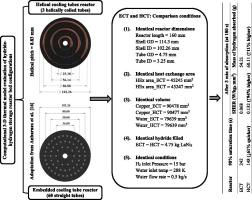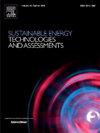均质条件下不同氢化物床配置的比热萃取率和吸收率比较研究
IF 7.1
2区 工程技术
Q1 ENERGY & FUELS
Sustainable Energy Technologies and Assessments
Pub Date : 2024-10-22
DOI:10.1016/j.seta.2024.104035
引用次数: 0
摘要
本研究在保持接触表面积和热交换器体积相同的情况下,考察了嵌入式冷却管(ECT)和螺旋盘绕管(HCT)反应器几何结构的吸收性能,从而根据比热萃取率(SHER)和 90% 饱和时间确定更好的床层配置。ECT(由六十根直管组成)和 HCT(由三根螺旋管组成)的直径(4.75 毫米)、热交换体积(90477 立方毫米)以及与氢化物的接触表面积(45245 立方毫米)相同,但供应压力(5、15、25 巴)、进水温度(278、288、298 K)和流速(0.1、0.5、0.9 千克/秒)各不相同。在供氢压力方面,HCT 反应器的性能优于 ECT 反应器,吸收时间缩短了 1.5 至 1.6 倍。进水温度的变化导致在吸收等量氢气的情况下,HCT 的吸收速度比 ECT 快 34-38%。质量流量表明,与 ECT 相比,HCT 的吸收速度平均快 30%。总之,在所有操作条件下,HCT 的 SHER 都几乎是 ECT 的两倍,从而强调了使用螺旋盘绕管的益处。本文章由计算机程序翻译,如有差异,请以英文原文为准。

A comparative study of specific heat extraction rate and absorption for distinct hydride bed configurations under homogeneous conditions
The current study examines the absorption performance of the embedded cooling tubes (ECT) and helically coiled tubes (HCT) reactor geometries by keeping the contact surface area and heat exchanger volume identical to determine the bettered bed configuration based on specific heat extraction rate (SHER) and 90 % saturation time. The ECT (comprising sixty straight tubes) and HCT (comprising three helical tubes) of the same diameter (4.75 mm), heat exchange volume (90477 mm3), and contact surface area with the hydride (45245 mm3) are subjected to variations in supply pressure (5, 15, 25 bar), water inlet temperature (278, 288, 298 K), and flow rate (0.1, 0.5, 0.9 kg/s). The HCT reactor demonstrated superior performance to the ECT reactor concerning hydrogen supply pressure, reducing absorption time by 1.5 to 1.6 times. Variations in water inlet temperature resulted in HCT highlighting 34–38 % faster absorption than ECT for an equivalent quantity of hydrogen absorbed. The mass flow rate indicated that absorption was, on average, 30 % faster for HCT compared to ECT. In conclusion, it was observed that the SHER of HCT is nearly double that of ECT across all operating conditions, thus emphasizing the beneficial aspect of utilizing helically coiled tubes.
求助全文
通过发布文献求助,成功后即可免费获取论文全文。
去求助
来源期刊

Sustainable Energy Technologies and Assessments
Energy-Renewable Energy, Sustainability and the Environment
CiteScore
12.70
自引率
12.50%
发文量
1091
期刊介绍:
Encouraging a transition to a sustainable energy future is imperative for our world. Technologies that enable this shift in various sectors like transportation, heating, and power systems are of utmost importance. Sustainable Energy Technologies and Assessments welcomes papers focusing on a range of aspects and levels of technological advancements in energy generation and utilization. The aim is to reduce the negative environmental impact associated with energy production and consumption, spanning from laboratory experiments to real-world applications in the commercial sector.
 求助内容:
求助内容: 应助结果提醒方式:
应助结果提醒方式:


